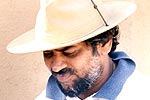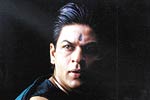

|
|
|
* The story in Pictures * Wallpapers |
|
|
Shah Rukh Khan
Kariena Kapoor
Hrishitaa Bhatt
Rahul Dev
Subhashini Ali
Raghuveer Yadav
Gerson Da Cunha

Author, Making of Asoka
Costume Design
Art Decor
Publicity
Photography
'I wanted to make a raw film' - Santosh Sivan
What made you choose Emperor Ashoka as the subject of your film?
All my films Malli, Halo and Terrorist, were made based on images that had left an impression on me. Malli was a story that I learnt in school. Halo was based on a small girl I knew. Terrorist was based on Rajiv Gandhi's assassination.
I owe Asoka to my History teacher in school, P G Jacob. He'd take class for us after lunch hour. He'd walk across the class as if he was leading the soldiers and enact every single incident. Perhaps, he wanted to be an actor and he was fulfilling that desire by enacting scenes from our history textbooks. He made his classes very interesting. We always looked forward to his lectures.
I wanted to retain that narrative flavour in the film as hundreds of legends surround the Emperor. All of them portrayed him to be very cruel. And that is why his transformation, from bad to good, is even more dramatic.
Has Asoka stayed within you all these years, then?
It wasn't always on my mind, but it came back to me often enough. When I made Malli, a friend asked me what film would I really want to make now. A film on Ashoka, was my answer. So, we began researching in all earnest.
Asoka wasn't to have been made with such a big canvas. How did it finally happen?
The whole idea of making the film was to portray an image I had as a filmmaker. I didn't want to make films, which have people exclaim, "Oh! This is like an Iranian or an English film." I want to make an Indian film.
Is Asoka a truly Indian film?
Of course. And it's high time. We all need to be proud of an Indian film. Sometimes, we as filmmakers veer off track but the whole system of story telling through songs and dance is interesting. It's like my grandma telling me a story.
The story of Ashoka would be more interesting if I used that format. And I wanted songs in Asoka.
That's surprising considering that your other films had no songs at all…
I do like songs. You can communicate better with a song. I wanted the songs to lend flavour to the film. I was depicting a period when India was known for its religion and its folk songs.
I was fascinated with the way Raj Kapoor and Mani Ratnam picturised songs. The songs of Asoka are a tribute to them in my own way!
How did you visualise Ashoka?
The more I thought about Ashoka, the more perplexed I got. I couldn't imagine how a person who killed mercilessly transformed himself to a disciple of Buddha.
I was intrigued by the transformation. We had to dramatise the story to achieve that dramatic change. There was another beautiful story about a girl. Orissa fables have her as a princess but edicts claim that she's a fisherwoman's daughter. I made her the fisher woman. That was to be my backdrop for the film.
I wanted film to be Ashoka's journey through various emotions. When making the film, I tried not to see the image of Ashoka; I was trying to discover every human being and the changes he must go through. You need a lot of courage and guts of steel to change. That was what fascinated me.
You said you dramatised the story. How much liberty did you take?
We had to dramatise to show the magnitude of the change and also to create an impact. We basically followed his life but we added characters and created dramatic moments.
You used various seasons to depict the moods of Ashoka as he transforms from a bad person to a good person. Was it a conscious decision?
Yes. With Terrorist, I experimented with water taking different forms -- the waterfall, the serene pond. I wanted to create a parallel between the protagonist's mind and the way water behaved. Water was my medium to depict her moods.
With this film, I wanted to use nature in its different moods. We all go through different emotions as nature changes -- we're nostalgic when it rains, but that changes when the weather gets hot and dusty.
I liked the idea of shooting the film in transition, one season changing into another. I liked the illusion of a day growing into night, when there is no shadow. There is a presence of darkness and light and that is when people light the lamp. Mysterious moments. I like them.
Why did you shoot the climax at twilight when there was no shadow?
That's the time when the Emperor actually realises what he's done. He's on the battlefield with both the moon and the sun watching over him. The transformation takes place when there are no shadows, when we're in total harmony with nature.
Would you rate yourself higher as a technical person or as a creative being?
As a creative person. I was asked often, how I manged to shoot the song Chaiyya, chaiyya in Dil Se. But that technical aspect was immaterial to me.
I wanted to recreate what you went through when you first went through a train journey; the feeling that you experienced while coming out of a tunnel. I was trying to recreate that fascination.
In Asoka, we shot in the mists of Panchmari, the heat of Madhya Pradesh, the dust in Jaipur. I didn't want too many sets in my film. I wanted to capture the period in all its bareness. I would perhaps lead one to believe that Asoka was an art film. It's not…It is a Hindi film with songs.
Why venture into Hindi cinema? Why choose Shah Rukh Khan as Ashoka?
A filmmaker uses visuals as his language. If you can see Little Buddha in English, you can see Asoka in Hindi!
It's easy to make people act; you take somebody from real life and tell them to do whatever they do in real life and they do a wonderful job. You saw them in Terrorist. But the fact is they were not acting; they were being themselves.
However, when you have a character that has to go through changes and feel different emotions, you need a fantastic actor. Ever since I saw Shah Rukh, I always thought that he was someone who could carry all the shades in Ashoka's life effortlessly.
There are many actors who can portray the first two transitions; the ambitious guy and the romantic guy. But the evil Ashoka is really difficult to portray.
Was SRK selected because he was the producer?
No. I chose him when Dil Se was being shot. He came in as the producer much later.
How difficult was it to conceptualise the war of Kalinga ?
When I started the film, I decided it would have no special effects. I wanted to make a raw film, not the usual period film. It was not like the typical war sequences that you have seen earlier. I used kalari artists from Kerala to depict the war. There's something very interesting about bareness.
Santosh Sivan spoke to Shobha Warrier